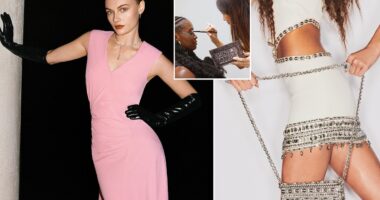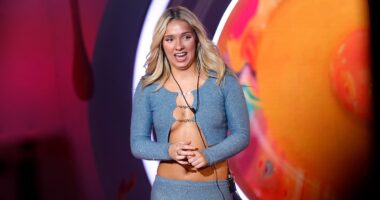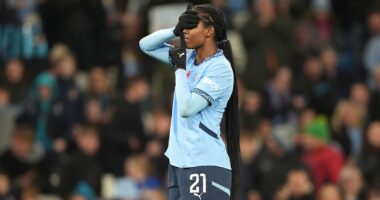A racetrack in the blazing, melting Florida heat is a difficult place to be glamorous, but Charlotte Tilbury likes a challenge. Her powder is set, her cheekbones are lifted and her eyeliner is definitely not creasing as she power-walks down the grid before the first women’s race of the Miami Grand Prix. This is new terrain for Tilbury, who made her name as a celebrity make-up artist in the 1990s and 2000s, becoming famous for her work for high-fashion magazines and runway shows. In 2013 she launched her eponymous line of cosmetics, and went on to name her lipsticks after the starry clientele for which she originally blended the shades. It helped women identify how they could achieve the looks they saw in Vogue, but it was also a savvy bit of marketing, turning famous clients into walking advertisements for her products. In 2020, she sold a majority stake to Spanish fashion house Puig in a deal estimated to be worth $1.2bn. She remains CEO and chief creative officer, and the engine room of the brand’s evolution. Today, in high heels and a catsuit, she is posing beside the F1 Academy car (operated by Rodin Motorsport) that she began sponsoring in February. The car’s livery is nose-to-tail in pink lips, from which lipsticks dangle like cigarettes. Inside sits 18-year-old French racing driver Lola Lovinfosse, conferencing with her coaches underneath an umbrella to shield from the sun. Over the body-vibrating roar of live engines, Tilbury – a human disco ball of positive affirmations – calls out “Darlings!”, pulling in the gathered beauty influencers for a group shot. Until now, sponsors on the Formula One circuit have mostly been brands associated with motor oil or engine parts – or, in a notable exception, an energy drink. Tilbury’s brand sponsorship of the F1 Academy, the women’s league led by Susie Wolff (a former racing driver and one of the most prominent women in motorsport), is new for this asphalt empire. It is the first beauty sponsor, as well as the first female-founded brand to sponsor the F1 Academy. “I love breaking rules, breaking the status quo,” says Tilbury, who received an MBE in 2018. “The world still isn’t where it should be in terms of supporting women… Just because things have been done a certain way forever, why do they have to be that way? Why can more women not be represented in sport?” The sponsorship opportunity was serendipitous: Tilbury had been looking at getting involved in sport, loved the goal of elevating women and is a self-described “adrenaline junkie” who used to go-kart as a child and would watch F1 with her dad. “I had to do it,” she says of the partnership. Tilbury has a close and intense way of speaking; it feels like we’re swapping relationship stories more than discussing a sponsorship deal. Her ability to make a friend of you in under two minutes is legendary. On our third meeting, in a chaotic scrum of people before the race, she tells me that she loves me. It’s hard not to surrender to her gravitational pull. When the starting flag waves – or the light blinks – signalling drivers to step on the gas, the stadium hum is drowned out by engines. “There’s something otherworldly about F1,” says Tilbury. “It’s euphoric. It’s exciting. It’s adrenaline. It’s like everyone’s buzzing. It’s kind of chaotic.” And then, once the cars make the first turn, it is strangely quiet. The smell of petrol lingers, and I become acutely aware of how hot it is standing in the sun. The F1 Academy is a plan as much as it is a programme to foster female talent in motorsport. It comes at a time when the fast-growing sport is under scrutiny for its treatment of women. Red Bull principal Christian Horner was accused of inappropriate conduct towards a female employee in the off-season, igniting headlines. An internal private investigation has since cleared him of allegations, but the scandal continues to dog the sport. Since Formula 1 was founded in 1946, there have only been two women start a race at the top level, in 1958 and 1975. Susie Wolff came close. After she joined the Williams Racing F1 team in 2012 as a development driver, she became the first woman to participate in an F1 weekend in 22 years. But she left the team in 2015. Wolff’s office in the F1 Academy paddock backs up against the barricade to the racetrack, and periodically during our meeting her Scottish accent is drowned out by a roaring Porsche. At first, the location would seem to be in a backwater of the stadium, far from the men’s garages located in the centre. But this is by design, Wolff explains. She wanted the Academy to be where the fans are, not just those who can afford to pay for the highest levels of access. “That’s what Formula 1 is like – unless you’re in the Paddock Club, or unless you’re with a team, you don’t get in,” she says. Paddock Club tickets on the F1 calendar can cost $15,000 for the weekend. “We wanted to make it more accessible.” Raising the profiles of female drivers is also a strategic business decision by F1. Women now account for around 40 per cent of the racing sport’s fan base, a TV viewership that for the 2023 season cumulatively reached 1.5bn, and the fastest-growing segment of those viewers is under 25. “I don’t want people to think that I’m on a feminist crusade,” Wolff says. “There’s a real business element to it for F1. I believe we can create value for Liberty Media [which owns F1], for the stakeholders.” The F1 Academy is also not the first attempt to build a women’s racing programme. The W Series, an all-female championship, folded in 2022 after three seasons, due to lack of funding. The costs of rising through the ranks has long been a deterrent. The W series also ran independently of F1. “The F1 Academy is one piece of the puzzle to creating gender equality in motorsport, it is one step on that journey,” says Kate Beavan, who worked at F1 for more than 18 years and is a strategic adviser to More Than Equal, a non-profit dedicated to increasing representation of women in motorsport. “The Academy has to show that it is successful in pushing women up to the top echelons of motorsport – and that is the acid test that nobody can answer right now.” The initiative cannot be separated from its potential commercial opportunities, Beavan says. “It is a growth opportunity any other sport would kill for; a burgeoning young new female audience.” “I think women’s sport initially needs investment, but then has to find a way to be financially sustainable,” says Wolff. When she took over what was left of the series into the F1 Academy, she had to find new sponsorship for all the cars. “There was a moment where I had 15 cars to sell, which was intimidating.” What Wolff hopes will set the Academy apart is the direct buy-in from the top men’s teams. Each of the 10 Formula 1 racing teams supports an Academy car, and lends their liveries to a driver – a first. “When I had the idea for getting the F1 teams on board, they said, ‘That’s going to be impossible,’” says Wolff. “But once I had the top four teams, I had some momentum. Then I got to the golden number six – more than half. There were a few people saying, ‘Well, you’ve backed us into a corner. Now if we don’t do it, we’re gonna look really bad.’” Wolff also dealt with a personal backlash. Members alleged that there was a conflict of interest between her and her husband, Toto, who is the principal and part owner of the Mercedes F1 team. In March this year, she filed a criminal complaint against the sport’s governing body and released a strongly worded statement laying out the reputational damage she had suffered as a result. The F1 Academy races at Formula 4 level, where achievable top speeds are around 165mph – compared with more than 220mph in F1. Formula 4 cars are all the same, a chassis chosen for its lower costs and ease of maintenance. This helps to level the playing field and identify racing talent without the obscuring advantages of deep pockets and horsepower. Drivers receive the same amount of funding from the F1 Academy, and are required to financially contribute to their racing, as in F1, which Wolff hopes will lead to greater sustainability for the Academy. “They need to know what it’s like to raise money because they need to, to go into the next category. How to present yourself, how to get partners on board. They own spots on their sleeve; they own parts of the helmet.” Driver Lola Lovinfosse’s goal, and childhood dream, she says, is to race in Formula 1. “If you asked this question of 15 girls on the track they would all reply the same,” she says. “When you’re a woman, it’s even more difficult to believe in yourself and believe in the fact that you will get into Formula 1.” She adds: “The F1 Academy makes everything more serious, and more easy to believe.” F1 the franchise benefited tremendously from a Netflix documentary series called Formula 1: Drive to Survive. F1 racing is a sport about underdogs and top dogs, disappointments and redemptions, and the series delivered those storylines straight into homes. The pandemic saw a surge in viewership, just in time for a highly dramatic, some say “gladiatorial”, 2021 season. The women’s league is now filming its own documentary series, produced by Hello Sunshine, actor Reese Witherspoon and Lauren Neustadter’s production company – which Wolff fought to get onto Netflix. Cameras trail the female drivers, capturing sweaty post-race frustrations and sweet moments with young fans. “Bearing in mind I was a driver for over 25 years, and I ran a team for four years, I have never seen so much momentum towards diversity. We talked about it for so many years but actually there’s real action taking place,” Wolff says. She knew the women’s league was going to need big, disruptive sponsorships. “Sponsors that are already in the sport – not all of them wanted to have anything to do with us,” she says. “I’m not here for charity. I’m going to show you that you missed the opportunity to be in the F1 Academy.” Tommy Hilfiger, Puma and Amex have also lent sponsorship to the Academy. When Wolff called Tilbury about potential sponsorship, the answer was an immediate “yes”. Eleven years ago, when Tilbury launched her brand, “people told me, there are five players in the industry, why would you bother?” She says, “They said it’s an overcrowded market.” Doing it anyway, “there’s a fearlessness to that”. Tilbury says she felt an immediate affinity with the chronically underestimated women of motorsport. “People sometimes say to me, ‘Do you run the business?’ I’m like, ‘Yes, I run the business,’” she says. “I did all the rounds of fundraising. I built it. I look at the P&L every single day. Everything is in the numbers. I don’t know how you market or create without understanding the commercial side of things.” Her F1 Academy hospitality trailer has generated mild shock from dyed-in-the-wool F1 crew: it is filled with her products, and make-up artists giving touch-ups to guests. But the overlap between her customer base and the growing fanbase of F1 is not lost on Tilbury; her brand is expanding into a $16bn global sporting franchise. She also sees an opportunity to use her in-house marketing power and influence to boost the profile of the F1 Academy. “The first time I drove the car, I felt very proud. You feel like all the eyes are on you,” Lovinfosse says of her bold, lipstick-covered livery. There is still a way to go for women’s racing, but Tilbury says she is invested for the long haul. The stands during the women’s race are still only partially filled, unlike the surging crowds that descend before the men’s races later in the day. But Miami represents a sort of arrival for the Academy, a proof of concept. Wolff says that this weekend, finally, people have been coming up to her and saying, “‘OK, now we get it.’ “There was one iconic shot in the grid today. I saw these really well-dressed, young, cool women standing with Charlotte in front of the car,” she says. “And it’s like, this is cool.”
Subscribe
Login
0 Comments





